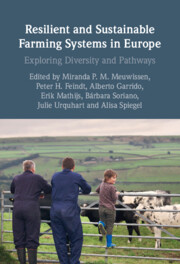Figures
1.2The eleven farming systems included in the SURE-Farm assessments
1.3Resilience assessment requires knowledge from multiple disciplines
2.1Fifty most frequent words and word combinations in response to open questions on major perceived challenges and risk management strategies in the next twenty years
3.2Understanding farm generational renewal through three conceptual stages and factors influencing them at four different levels: the individual, farm, farming system, and society
3.4Evolution of Gross Value Added based on farm profits, rent, wages, and interest (in €/ha)
5.1Position of the three European CS agricultural systems on Therond et al.’s biotechnical and socio-economic framework
6.1Importance of dairy farming in Flanders per municipality (euro standard output per hectare) in 2017
A6.1Factsheet synthesising resilience of the current farming system in Flanders (Belgium)
7.1Northeast Bulgaria landscape during the spring and autumn
A7.1Factsheet synthesizing resilience of the current farming system in Northeast Bulgaria
A8.1Factsheet synthesising resilience of the current farming system in the Altmark (Germany)
A9.1Factsheet synthesising resilience of the current farming system in Huesca (Spain)
10.1Charolais cows in the grassland landscape of the Bocage Bourbonnais
10.2Perceived performance of functions (left panel) and importance assigned by different groups of stakeholders (right panel) during a participatory workshop in the Bourbonnais farming system held in February 2019
A10.1Factsheet synthesising resilience of the current farming system in the Bocage Bourbonnais (France)
11.2Impacts of challenges on key aspects of the hazelnut farming system in Viterbo
A11.1Factsheet synthesising resilience of the current farming system in Viterbo (Italy)
A12.1Factsheet synthesising resilience of the current farming system in the Veenkoloniёn (the Netherlands)
13.3Causal loop diagram depicting the relations between indicators, challenges, resilience attributes and possible strategies in the horticulture FS in Poland
A13.1Factsheet synthesizing resilience of the current FS in Mazovian and Lubelskie (Poland)
14.2Causal loop diagram for the farming system in the Nord-Est region in Romania
A14.1Factsheet synthesizing resilience of the current farming system in the Nord-Est region in Romania
A15.1Factsheet synthesizing resilience of the current farming system in Southern Sweden
16.2Challenges of the EE farming system over the next twenty years as perceived by farmers
16.3Farmers perception of trust in different sources of information
A16.1Factsheet synthesizing resilience of the current farming system in the EE (UK)
17.1Perceived performance and importance of functions as assessed by stakeholders in the SURE-Farm case studies
17.2The contribution to resilience attributes of the identified strategies implemented and proposed in farming systems
17.3A causal loop diagram showing how economic, social, and environmental functions and attributes are related
18.1Causal loop diagram of the shifting-the-burden archetype
18.4Causal loop diagram of the success-to-the-successful archetype
19.1Interface of the challenges defined in the digital co-creation platform
19.2(Mis)matches in the stakeholders’ perceptions about current resilience and resilience in the future
19.3The stakeholders’ perception of the challenges of the European farming systems
19.4Perceived importance (size of circles) and performance (y-axis) of FS functions
19.5Strategies to deal with future challenges proposed by the stakeholders



